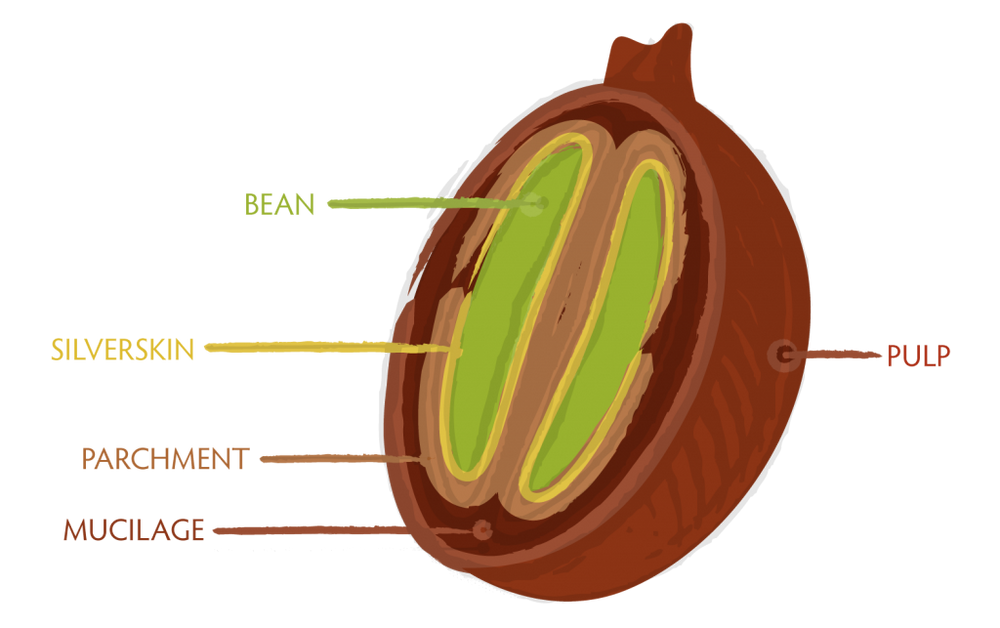Traditional Coffee Processing Methods

Types of coffee processing
The coffee you may be drinking while reading this has gone through many steps to find its way to your cup. From its start as a humble seed, 5-6 years have transpired before any coffee cherries can be harvested for processing. Perhaps the caffeine has stimulated your thinking to wonder how coffee is processed post-harvesting to prepare the beans to be roasted and brewed? This brief overview will discuss the three ways that coffee is traditionally processed: washed, natural, and honey. There are other methods employed, but these three are the most common.

Washed Coffees
Washed coffees focus solely on the bean inside the coffee cherry that is picked from the plant. Washed coffees let you taste what’s on the inside, not the outside.
A natural or honey processed coffee requires a very flavorful coffee cherry, including the outer layers. In contrast, washed coffees depend heavily on the bean absorbing enough natural sugars and nutrients during its growing cycle. This makes many factors important when selecting this processing method, including the varietal, the soil, weather, ripeness, fermentation, washing, and drying are all key.
Washed coffees reflect both the science involved in growing coffee, as well as the expertise of the farmers who are an integral part of crafting its taste. With washed coffees, the country of origin and environmental conditions add to the flavor.
This means that the washed process highlights the true character of a single origin bean like no other process. It’s why so many specialty coffees are washed.
A downside of washed coffees is the high volume of water required to process enough beans for just one of cup – approximately 35-40 gallons. This number is not consistent across all growing regions but is an average.
Natural/Dry Processed Coffee
The natural process, also known as the dry process, has its origins in Ethiopia, the birthplace of coffee. In this process, the fruit remains on the bean, and dries naturally. Although it needs less investment in equipment and labor, it still requires certain climatic conditions to ensure the proper drying of the fruit and seed.
Over time, the natural process has become considered a lower-quality method that can lead to inconsistent flavors. This inconsistency is often the result of unripe fruit drying and turning brown alongside ripe fruits.
That said, this process has the potential to create extremely flavorful coffees, especially if consistency in choosing only the ripe fruit for processing is achieved. Many coffee producers believe natural coffees can match washed coffees for clarity and provides some more interesting tasting notes and characteristics as well.
And a big plus is that the natural coffee is the most eco-friendly, primarily from the savings in water usage over washed methods.
Honey/Pulped Natural Coffee
When done right, honey processed coffee can literally taste like someone has put honey and brown sugar in your cup of coffee – although the name comes from how sticky the beans get during processing. In many ways, this type of coffee is halfway between a washed coffee and a natural process coffee. It’s fruity, but not in as exaggerated a way as some natural processed coffees. It often has a more rounded acidity than washed coffees, with intense sweetness and complex mouthfeel.
The honey process is strongly associated with Costa Rica including subcategories such as yellow, red, golden, black, and white honey. This reflects the ability that the honey process has in influencing the taste and overall profile of a coffee. It can become a highly scientific process by monitoring and controlling the level of mucilage (the fruity layer between the coffee cherry and the outer skin) which influences the sweetness and depth of body of the coffee. Typically, the more mucilage left on the bean, the sweeter the taste.
Deciding on what process to use
Most coffee producers want to produce the most profitable and best-tasting coffee they can, but their environment limits them. Coffee, more so than most foodstuff, has a very close bond to its surrounding environment.
Producers will often wait to see how much rain has fallen before deciding whether to produce washed, honey, or natural coffee. Heavy rain makes it harder to produce good natural process because coffee cherries can start splitting. If it hasn’t rained, conditions are great for honey process or natural process because no sugars will get washed away.
Producers often use refractometers to measure sugar content. This helps decide if the sugar content is high enough for natural processed or honey processed coffee.
Conclusion
Coffee processing rarely makes it into the headlines or café discussions, but it’s an integral part of crafting the flavor and character of your cup of coffee. So next time you pick up a honey processed Costa Rican or a natural processed Nicaraguan, you’ll know what to look forward to.

Leave a comment